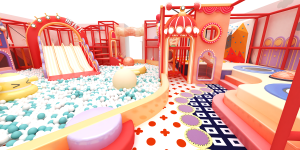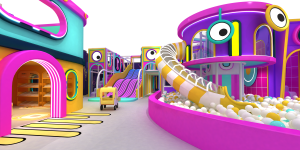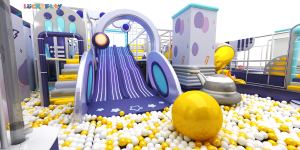Introduction
Creating a playground for your community is an exciting yet challenging task. Whether you’re planning a new playground for a school, park, or recreational center, choosing the right commercial playground equipment is crucial to ensuring a safe, engaging, and inclusive play environment for children. With so many options available on the market, it can be overwhelming to decide which equipment will best serve the needs of your community. In this article, we will guide you through the process of selecting the best commercial playground equipment, considering factors such as safety, inclusivity, durability, and budget. By the end of this article, you’ll be equipped with the knowledge to make informed decisions that will benefit your community for years to come.
Understanding the Importance of Playground Equipment
Playgrounds are more than just spaces for children to have fun; they are essential for their physical, social, and cognitive development. The good playground equipment can encourage physical activity, stimulate creativity, and foster social interaction among children of all ages. Moreover, playgrounds provide a safe and structured environment where children can explore, take risks, and learn important life skills. Understanding the impact that playground equipment can have on a child’s development underscores the importance of making thoughtful and informed choices when planning a community playground.

Assessing the Needs of Your Community
Before diving into the selection of playground equipment, it’s important to assess the specific needs of your community. Every community is unique, and the playground should reflect the characteristics and requirements of its users. Consider the following factors:
- Demographics: Understand the age range and number of children who will use the playground. This will help you choose equipment that is appropriate for different age groups, from toddlers to teenagers.
- Community Values: Consider what your community values most in a playground. Is it safety, inclusivity, environmental sustainability, or something else? These values should guide your selection process.
- Space and Location: Evaluate the available space and its surroundings. Is the playground going to be in a residential area, a school, or a public park? The location will influence the type of equipment that is suitable.
- Weather Conditions: Consider the local climate. For example, in areas with intense sun, you might need shade structures, while in regions with heavy rainfall, equipment should be weather-resistant.
- Budget: Understanding your budget constraints is essential. It will help you prioritize features and decide where to allocate resources for maximum impact.
Prioritizing Safety First
Safety is the most critical factor when choosing commercial playground equipment. A playground should be a place where children can play freely without the risk of injury. Here are some safety considerations to keep in mind:
- Compliance with Standards: Ensure that all playground equipment meets or exceeds safety standards set by organizations such as the Consumer Product Safety Commission (CPSC) and ASTM International. Equipment should also comply with the Americans with Disabilities Act (ADA) to ensure accessibility for all children.
- Quality of Materials: The materials used in playground equipment should be durable, non-toxic, and free from sharp edges or small parts that could pose a choking hazard. Common materials include heavy-duty plastic, metal, and wood, each with its own set of safety considerations.
- Fall Protection: Install proper surfacing under and around playground equipment to cushion falls. Options include rubber mulch, sand, pea gravel, or engineered wood fiber. The surface should be soft enough to absorb the impact and reduce the likelihood of injury.
- Regular Maintenance: Choose equipment that is easy to maintain and inspect regularly for wear and tear. Regular maintenance is key to ensuring that the playground remains safe for use over time.
- Age-Appropriate Design: Ensure that the playground equipment is suitable for the intended age group. For example, younger children need lower platforms, smaller slides, and equipment that promotes safe, developmental play, while older children may require more challenging structures.

Focusing on Inclusivity and Accessibility
An inclusive playground is one where children of all abilities can play together. Inclusivity should be a top priority when selecting top playground equipment. Consider the following:
- ADA Compliance: Ensure that the playground is ADA-compliant, meaning that children with disabilities can access and enjoy the equipment. This includes providing ramps, transfer stations, and accessible pathways.
- Variety of Activities: Include a diverse range of activities that cater to different abilities and interests. For example, consider swings that accommodate wheelchairs, sensory panels for children with sensory processing disorders, and tactile surfaces for visually impaired children.
- Social Interaction: Choose equipment that encourages social interaction among children of different abilities. This could include cooperative play structures like seesaws or group swings, where children can play together.
- Quiet Spaces: Provide quiet areas where children who may become overwhelmed can retreat to calm down. These could be shaded areas with benches or small enclosed spaces within the playground.
Durability and Material Considerations
Investing in durable playground equipment is essential for ensuring the longevity of your playground. Durable equipment not only withstands heavy use but also reduces long-term maintenance costs. Here are some material considerations:
- Metal Equipment: Metal is highly durable and can withstand extreme weather conditions. However, it can become hot to the touch in direct sunlight, so consider shade structures if you choose metal equipment.
- Plastic Equipment: Heavy-duty plastic is a popular choice due to its durability, versatility, and ability to retain color over time. It’s also less likely to splinter or crack compared to wood.
- Wood Equipment: Wood offers a natural aesthetic and is often preferred for its environmental benefits. However, it requires regular maintenance to prevent rot, splinters, and insect damage.
- Composite Materials: Some playground equipment is made from composite materials, which combine the durability of plastic and the aesthetic appeal of wood. These materials are often resistant to weather and require less maintenance.
Considering Aesthetic Appeal and Thematic Design
The design and aesthetic appeal of a playground can significantly enhance its attractiveness and usability. A well-designed playground with a cohesive theme can inspire imaginative play and create a unique identity for your community space.
- Thematic Playgrounds: Thematic designs, such as nature-themed, space-themed, or nautical-themed playgrounds, can ignite children’s imaginations and provide a more immersive play experience. These themes can also reflect the character of the surrounding community.
- Color Schemes: Choose a color scheme that complements the surroundings and appeals to children. Bright colors can attract attention and create a cheerful atmosphere, while more subdued tones can blend seamlessly with natural settings.
- Custom Designs: Some manufacturers offer custom design services, allowing you to create a playground that is uniquely tailored to your community’s needs and preferences. This can include incorporating local cultural elements or landmarks into the design.
Balancing Activity Zones
A successful playground incorporates different activity zones that cater to various types of play. By creating distinct zones, you can ensure that children of all ages and abilities have something to enjoy.

- Active Play Zones: These areas include equipment that promotes physical activity, such as climbing structures, monkey bars, and swings. These zones are essential for encouraging exercise and developing motor skills.
- Creative Play Zones: Creative play zones might include sandboxes, water tables, or art panels where children can engage in imaginative and sensory play. These areas foster creativity and allow children to express themselves.
- Social Play Zones: Social play zones are designed for group activities and can include features like playhouses, seesaws, or multi-user swings. These zones encourage teamwork, communication, and social interaction.
- Quiet Play Zones: Quiet play zones provide a space for children who may need a break from more active play. These areas can include shaded benches, gardens, or small play structures designed for solitary or low-energy activities.
Environmental and Sustainability Considerations
As communities become more environmentally conscious, the demand for sustainable playground equipment has increased. Choosing eco-friendly materials and practices can benefit both the environment and the longevity of the playground.
- Recycled Materials: Look for equipment made from recycled materials, such as recycled plastic or rubber. These materials reduce waste and often have a lower environmental impact than virgin materials.
- Sustainable Sourcing: Ensure that any wood used in the playground is sustainably sourced, with certifications from organizations like the Forest Stewardship Council (FSC).
- Energy Efficiency: Some playgrounds incorporate solar-powered features, such as lighting or interactive panels, to reduce energy consumption and promote renewable energy use.
- Water Conservation: If your playground includes water play features, consider systems that recycle or minimize water use.
Budgeting and Long-Term Investment
Creating a playground is a significant investment, so it’s important to budget carefully and consider the long-term costs associated with maintenance and upgrades.
- Initial Costs: Break down the initial costs into categories such as equipment purchase, installation, surfacing, and landscaping. Be sure to include a contingency fund for unexpected expenses.
- Maintenance Costs: Consider the ongoing maintenance costs of the playground. Some materials, such as wood, may require more frequent upkeep, while others, like plastic or metal, are more durable.
- Funding and Grants: Explore funding opportunities and grants that can help offset the cost of building the playground. Many governments and organizations offer grants for community projects, especially those that promote physical activity and inclusivity.
- Cost-Benefit Analysis: Perform a cost-benefit analysis to determine the value of investing in higher-quality, durable equipment versus more affordable options. While the initial cost may be higher, durable equipment can reduce long-term maintenance expenses and provide a better return on investment.

Engaging with a Trusted Supplier
Choosing the right supplier is as crucial as selecting the equipment. A reputable supplier can provide quality assurance, safety certification, and good customer service. They should also offer a range of products that cater to your specific needs.
Conclusion
Choosing the proper commercial playground equipment involves much more than picking a few colorful structures. It requires a deep understanding of your community’s needs, a commitment to safety, and a partnership with a reliable supplier. By following these steps, you can create a playground that will serve as a safe, enjoyable, and vibrant community hub for many years.
If you’re ready to start planning your playground or need more information on state-of-the-art playground equipment, consider reaching out to Eluckyplay. Their expertise and wide range of products can help you build a playground that truly makes a difference in your community. Visit their website to explore options and get expert advice on your project.









